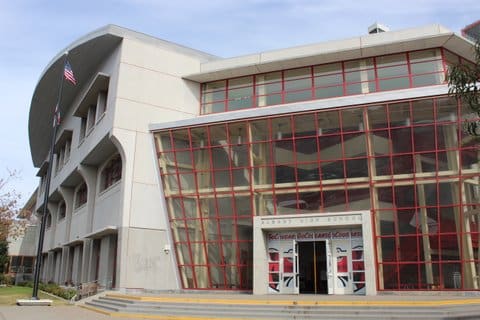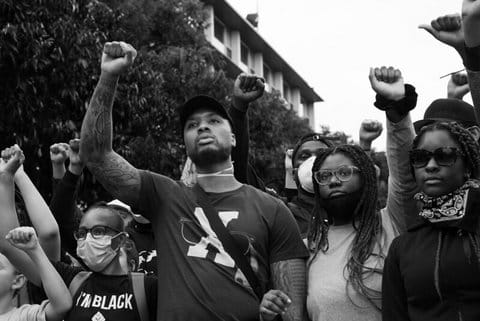
17 Oct Q&A: In ‘Accountable,’ Author Tells Story Behind Racist Albany High Instagram Account

Albany High students were both the posters and targets of a racist Instagram account that was revealed in 2017. (Natasha Kaye / The CC Pulse)
Interview, Natasha Kaye
At Albany High School in 2017, a racist Instagram account depicting hate speech and violence towards Black people came to light. The account’s creators were students at the school, and so were the victims. The story became a media firestorm, resulting in massive protests and calls for powerful action to be taken by the school’s administration and the Albany community.
Dashka Slater, an Oakland native and New York Times best selling author of “The 57 Bus,” picked up the story and followed the players involved as they reeled from the events. She turned her reporting into a book, “Accountable: The True Story of a Racist Social Media Account and the Teenagers Whose Lives It Changed,” and sat down for an interview with The CC Pulse to share more. This conversation has been edited.
The CC Pulse: What made you want to write this book?
Dashka Slater: I found out what happened with the Albany Instagram account when I was signing “The 57 Bus,” which is about … a hate crime involving two teenagers on a bus in Oakland. Somebody said, “Have you heard about what happened in Albany?” It had just happened. This was, probably, end of March 2017. I had not planned to have my next book be another soul-wrenching, devastating story about bias-based harm involving teenagers. I had that same feeling I had when I was working on “The 57 Bus”: really uncomfortable because values of mine were in conflict. Obviously, I’m repulsed, upset, concerned, outraged. I also believe in the ability of teenagers to learn and grow from their experience, and I am wary of punitive or carceral responses. I needed to understand what is happening. How could this have happened in this safe, liberal community that we all think we live in in the Bay Area?
RP: The book examines the histories of everybody involved and what led to the events that unfolded. You highlight the “harmers” — the posters. Why did you want to do that?
DS: Across the board — not just with racialized harm, not just with gendered harm, not just with harm committed by teenagers — there’s always a backstory. The cliche “hurt people hurt people” is true. People who feel good about themselves and have been raised with empathy, generally, aren’t the ones doing harm.
Girls tend to self-harm and turn inward when they’re in distress. Boys in distress tend to act out and harm others. It’s important to understand that dynamic and to be better as a society at helping people who are in distress so they (don’t) cause harm.
RP: Did you receive any backlash or criticism for taking this comprehensive route?
DS: I expected more than I received. People who know my work know this is what I do: I write complicated stories from multiple perspectives. I try to understand the dynamics behind the headlines. I believe in the dignity of all human beings, particularly young people, so I want to treat everybody with caring and empathy and respect even when they have done something horrifying. I’m always unsure whether people are going to go on that ride with me. I’ve been pleasantly surprised at how many have. Some are not on for that ride, and that’s fine. I don’t expect anybody to do that, particularly people who have been victims or survivors of hate or harm. Not everybody needs to (have) empathy for people who cause harm because sometimes you got to protect yourself.
RP: Do you think the school and the community handled this well?
DS: No. … Context is key. Three months after Trump was elected, the blue half of the nation was in a state of high alert. All of a sudden, things are looking very different than just a few months ago when we had a Black president and lots of people thought we’ve kind of solved racism. That comfort had been blown up.
A couple things made it hard to do a good job. One, the adults were just as freaked out and angry as the kids were. Everybody’s emotions were at an 11. The community was demanding a response and the kids were protesting and everything was at this very intense level. This tiny school didn’t have any experience. Half the administrators were brand new, so they really didn’t have the experience or the staff to really gain out “what is our best response?”
That said, it wasn’t for lack of care. It was lack of experience and a sense it was an emergency — let’s put out a fire rather than let’s take a breath and try to figure out how we can respond to the needs of the victims and their families. How can we address our community in a way that (validates) how much pain people are feeling? Then, how do we address the wrongdoing of this group of students and help them take full responsibility and make amends for the harm they’ve caused?
RP: What form of justice do you think this case falls under?
DS: It needed transformative justice, which is when you look at the whole damn system. Part of what happened in Albany was this desire … to eject the bad people from the community: If we make these 14 kids go away and never see them again, Albany will be fine. But any incident is the canary in the coal mine. All the factors that led to it are still in place. Many things needed to happen to make Albany a safer, more welcoming place. One narrative is Albany is a racist town, but Albany is an American town. These are issues in every community but particularly in affluent communities, where there is a tight little border around the “goodies” of society. The community could have used this as an opportunity for introspection.
RP: Ultimately, do you think the people who needed to be held accountable were?
DS: It depends what your definition of accountable is. People tend to mean punishment. Were they punished? They were. Everybody was suspended for the maximum allowed by the state. One was expelled. Most did not return to school. Yet, in the community, there tends to be this feeling they got away with something.
True accountability is an understanding that you caused harm. Taking responsibility — you did it — and understanding what that harm looked like and how it was experienced by the person or people that you harmed. Reflection on how you could do that, what was going wrong for you … and then beginning to make amends and figure out how to repair some of the damage, and finally, not do it again.
Each of the people who follow the account has a different journey, and I cover some of those journeys in the book. Most of the people I write about did reach accountability. It was a long and sideways journey, in part because of the punitive atmosphere. It was harder for these young people to accept the magnitude of what they had done because they were so demonized. A lot of the early conversations I had with people were them trying to prove to me that they’re a good person, which I don’t think should have been up for debate.
I could hear people saying, “Well, clearly they’re not good people because good people wouldn’t do that kind of thing.” But in restorative justice, we separate the person from the behavior. People who do bad things have the potential to do good things and often are doing good things while they’re doing bad things. The core humanity is almost always there. For the majority of people, and certainly for the majority of young people, the potential for transformation is there. But when people feel like their humanity is being rejected, they become defensive. What people often need to truly be accountable is support, enough that they can admit “I did a really bad thing,” and still feel “people are going to love me anyway.” That did happen for most of the people I wrote about, but it could have happened in a different way, maybe sooner if the community hadn’t been so completely shattered by the whole experience.
RP: How were the students who were targeted, the Black students, affected by this?
DS: In so many ways. This was shattering for them. Every young person is thinking about how they are going to move through the world. Adolescence is a tough time. You’re trying to figure out who am I, and do people like me, and should they like me, and do I want to change so they will like me. Black girls, particularly in majority white and Asian contexts like Albany, have to do all this extra work because with the anti-Blackness in society and the community, they’re trying to protect themselves from the fears they are not being taken seriously. They’re not considered desirable. This account feels like our meteor through the roof that just destroyed all their defenses. All the stuff they let go in the past suddenly they couldn’t let go. It was much more injurious because they were so vulnerable. We saw all kinds of responses: checking out from school, depression, anxiety; almost everybody talked about a fear of being watched, feeling like people are filming them, taking their pictures surreptitiously. Being really paranoid about putting anything on social media because it could be used against them. Because of racist stereotypes around Black anger, this feeling that the natural outrage and anger and indignation and all the big emotions that come from being targeted … had to be tamped down, or people would consider them too angry, too judgmental. One thing that happened to some of the girls was “stereotype threat,” which is basically being unable to perform well in academic areas where the stereotype says, you’re not going to be good. So lots of different impacts. None of them good.
RP: What can other high schools and communities in general learn from this story?
DS: First and most important is to start talking about social media and think critically about where some of this “funny” stuff is coming from — air quotes around funny — to help kids look deeply at the origins of stuff they’re consuming and who’s benefiting.
The other piece is working on school culture and empathy so people have deeper connections that allow them to speak up when they see something objectionable without feeling like they’re going to lose all their relationships. And that make people think about the impacts of their behaviors. Part of that is having a school culture that not only teaches about racism but also teaches about Black achievement and Black excellence and Black joy — same for all the racial groups. The last piece is having systems in place for when things go wrong, so people have a container to deal with it that does not blow apart their whole community, and so people have a way to figure out how to have true accountability and true help and support (for) survivors.
This resource is supported in whole or in part by funding provided by the State of California, administered by the California State Library in partnership with the California Department of Social Services and the California Commission on Asian and Pacific Islander American Affairs as part of the Stop the Hate program. To report a hate incident or hate crime and get support, go to CA vs Hate.






Deborah Wilson
Posted at 09:44h, 27 OctoberThank your for this Q&A. I had not heard about this event. I’m grateful for the wisdom provided here by author Dashka Slater.